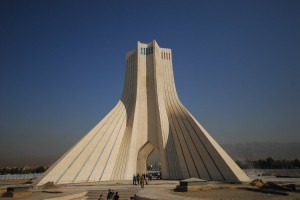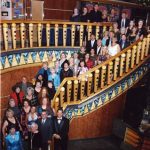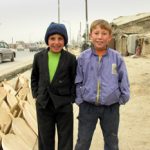Over the years when talking to a foreign tourist who has come to my motherland for the very first time I’ve gotten used to hearing expressions such as “wow! I see you have restaurants in Iran!”, or “Believe me Iran was not what I’d thought”, “I never thought you had such a beautiful country” and so on.
For the global public opinions and the mass majority who do not have any particular way of knowing a distant land rather than relying on the information given to them by the mainstream media i.e. magazines, TV channels, news websites and radio stations, Iran would enthusiastically be the most astonishing and enticing place one can ever see and explore in his/her lifespan.
When switching between TV channels that perpetually hold piping-hot debates between their guests talking, not clashing about Iran’s nuclear issue, you can see pictures of spacious, dry deserts with a sequence of camels running sluggishly, demolished buildings adjacent to the slums of downtown, ballistic missiles being test-fired, multitudinous hordes chanting political slogans while rallying in the covered streets and afterwards, some interlinked strings of nuclear power plants being shown from the aerial view.
What kind of perception one might catch from this partial and subjective “image-doctoring”? Undoubtedly, they would be convinced that the target country, which is Iran in this example, should be the most terrific and scaremonger chain in the “axis of evil” and full of terrorists, atomic bomb arsenals and a forgotten land, as well.
That’s why nearly all of those foreign, specifically western visitors who come to Iran for various purposes become perplexed and confused by what they see here; a bizarre confusion which begins from the early moment of their arrival in the airport and lasts until the final seconds of their bidding farewell with the “Ancient Persia”.
Less people, except those who are in favor of unveiling the truth by researching regularly, are informed that Iran is the same country of “Persia” with 15,000 years of ancient history and civilization, a monarchy that someday was gaining dominance over India to Egypt as the largest territory of all times, where Cyrus the Great has flourished and where the most remarkable personalities of science, literature and arts came from; Mevlana and Khawrizmi to Rhazes and Avicenna, Ferdowsi and Hafez to Khayyam and Rudaki.
Less people know that Iran is the land of Persepolis, Pasargadae and Apadana, the land of oldest known human civilization on the earth and the land of “Persian Gulf”, but they know well that Iran is “the axis of evil”! The prevalence of such assumptions has no reason but the dominance of treacherous, dishonest and malicious media that feed the public opinions with duplicity, doubtfulness and misinformation.
However, I believe that awakened, conscious people, who could still be found somewhere in the world, have an ethic duty of impeding the widespread expansion of such untruths and falsifications by divulging the reality and propagating it worldwide.
To do so, on behalf of myself and at least about my country, I derived the most possible benefits from an opportunity which has occurred last month and helped me conduct an interview with a non-Iranian journalist who had traveled to Iran for a same goal of mine: understanding the reality of Iran.
Jill Worrall is a well-known New Zealander travel journalist and international tour-guide who has co-written several books on the profile of her own country such as “Landscapes of New Zealand” and “Coastlines of New Zealand” with the patronage of her husband, moreover she is intending to write an elaborate book about her observations of Iran.
She writes a regular column in New Zealand Herald, which is the most prominent newspaper of the country, in which she tells the stories of her miscellaneous travels to different parts of the world as a regular wanderlust!
In the November 2008, she made her second trip to Iran heading a group of 29 other New Zealander tourists who voyaged to most of the important cities of Iran including Tehran, Yazd, Shiraz, Isfahan, Mashhad, Rasht, Qom, Ahvaz, and Kashan.
Pursuant to my prior liaisons with her husband, to whom I should express my warmest thanksgivings for the immense help he has provided, I conducted a detailed interview with Jill Worrall and questioned a load of challenging topics focused on Iran from the viewpoint of a non-Iranian visitor.
Following is the complete text of our conversation in which a number of delicate and interesting remarks could be implied if a minimum of talent and astuteness is employed.
Let’s add that when in the first question, I called Jill a famous travel writer, she denied submissively with a humble compliment and told that maybe she will become one day “Inshaallah”, but not know!
Dear Jill! It seems that you, like many of famous travel writers worldwide, have a special interest in Iran, its people and culture. Aren’t you afraid of dealing with a country which is branded as “the axis of evil”?
I have never believed the “axis of evil” label, specially given that the phrase was coined by someone for whom I have absolutely no respect and certainly no confidence in terms of his opinions. I’ve spent more than 20 years as a journalist and realized long ago that what is portrayed in the media and what is reality is often very different. I also believe that before you make any comment about a country, or for that matter any person, you should visit it first, see it for yourself and talk to the people there. Even then I don’t think people who visit a country are in any position to make judgments; observations maybe, but no more. What I have learned is that when it comes to traveling extensively in a country as I have in Iran it is a case of the “More you think you know, the less you know!”
Do you agree that Iran is the most misrepresented and misinterpreted country in the world? With a history of 15,000 years culture, many of the world citizens do not know it accurately yet, confuse it with Iraq or Afghanistan in most cases. What’s the main reason, in your idea, that there isn’t a clarified view of Iran for the world? Isn’t it a result of severe black propaganda on Iran and its people, running by the western media corporations?
I’ll answer this question in parts. To your first question Yes, I absolutely agree that Iran is the most misunderstood country in the world – in my experience at least but I suspect even among the countries I haven’t visited none gets quite as much bad press as Iran. It’s true that even many New Zealanders, who are legendary for being well-traveled, often think I’m going to Iraq and I’m afraid as you well know many people often mistakenly refer to it as an Arab country.
I think the reason for this is mostly ignorance. Clearly I can speak only even slightly authoratively as a New Zealander and as a whole New Zealanders are more outward looking and less likely to follow or believe US propaganda. So I think in the case of NZ it is mostly lack of information and also lack of contact with Iranians that leads to this confusion and misunderstanding. However it has to be said that media portrayals, which of course we see here too, both in print and in TV, do not help. There is a very stereotyped view of Iran on offer; largely, women in black chadors, people burning American flags. Scenes of white-coated men in power plant control rooms, that kind of thing!
I am not sure that all Western media organizations are out to blacken Iran’s name, there maybe some but to be honest I think most of it is the result of ignorance and sloppy journalism where journalists just repeat the stereotypes without considering if the reality is different, or even better still go there and find out for themselves!
If we don’t bound ourselves to moral and ethic framework of media professionalism and explicate the information with any kind of distortion or alteration stuck to it, then we too become propagandists. It is fine to take a positive view of a country and not dwell on the negatives but I believe as a writer and journalist we do have a duty to try to present a balance and not hide the facts. As writers we are in a privileged position as you say and we must take our roles very seriously as often people do take what we write to heart.
Given your punctual analysis of Iran’s portrayal in the mainstream media why did you choose to study and research about such a misunderstood and controversial country?
I made my first visit to Iran because I had spoken to several New Zealanders who had visited the country and absolutely loved it. So I started to read more about the country and it became my burning desire to travel there. The absolute main distinction that made it top of my list was what I had been told about the Iranian people. How warm, hospitable and interesting they were. It was this, not the scenery, the architecture or even the history that enticed me at first.
The last time, you came to Iran as tour leader heading a group of 29 New Zealanders with yourself. What was their conception before and after seeing Iran? What did they think and say about the country, its people, its culture, sights and attractions?
My group’s conceptions of Iran before they came were mixed. They’d read, seen and heard some of the common misconceptions and images about the country and the reason many were on the tour was because they wanted to find out more for themselves and because they were sure that the reality was very different. But even among the well informed members of the party and the well traveled there was so much surprise as they traveled the country and realized just how different it was to what they’d been led to believe.
They told me often that Iran was a constant surprise. Again like me, the Iranian people were the absolute highlight of their visit, followed by a range of things such as the beautiful mosques including Emam and Lotfollah in Isfahan, in fact all of Isfahan! Then for some people it was the caravanserai, the shrine at Mashhad, the old city in Yazd, the bazaar in Tabriz. Honestly the list could go on and on. Then of course there’s Persepolis, their enjoyment of our Persian poetry readings that are always part of our tours, fresh dates.
Generally their views on Iran were transformed and they were all planning to come home and spread the message!
About the main reasons of people feeling so anxious before going to Iran and their transformation of thoughts after observing the realities there, I believe that media reports and images that are regularly beamed into our living rooms are culprits. People worry that while they are in Iran some other country might attack Iran, or that that they have been led to believe that if their headscarf maybe slips for a minute they will be put in jail!
Which component or portion of Persian culture attracts you the most? How is your familiarity with Persian painting, music, literature, cuisine, clothing and the other symbols of Persian culture?
I think it is the people themselves. I feel so lucky that I have been adopted by an Iranian family. I love Iranian family life. But after that I absolutely love Persian poetry, from Hafez to Sepheri. I knew about Omar Khayyam, of course, because my late father adored the Rubbaiyat (double couplets) but when I discovered Hafez, Rumi, Sa’di and Sepheri, to name but a few it, as we say “blew my socks off” It was love at first sight.
But I also love miniature paintings, Persian architecture and decorative tile work and I am addicted to “Fesenjan”, Iranian rice, dates, tea, “Gaz”, saffron ice cream, any Khoreshet (stew) that you offer me, the cake from Qom which I can’t remember the name for, pomegranates .shall I keep going?
Undoubtedly you have visited various countries other than Iran during your professional career. What would be the most apparent differences of Iran with the other countries, in your view?
I think the overwhelming friendliness of the Iranian people is totally beyond what I have found anywhere else in the world. Other differences would be of course that there is a dress code for women which is different from most places I visit; a thirst for knowledge of the outside world and also desire for acceptance or understanding from the West; and if I can say this, maybe a desire for a little more freedom to make more decisions about one’s own lifestyle and expression of beliefs for oneself. For a New Zealander and thus from such a tiny country that many people can not even find on the map and that has so little strategic or political importance in the world I do find it very thought-provoking to be in a country that is so pivotal on the world stage and also that is both perceived as both a major threat and a target. It is almost impossible for me as a New Zealander to imagine what it is like to be in this position!
As you may know, Iran has 9 UNESCO world heritage sites registered, along with thousands of other national heritage sites that are not yet introduced internationally. What do you know about them, and which one was your favorite, more than the others?
I have been fortunate enough to visit almost all the nine registered sites with the exception of Bam; tragically I first visited Iran after the earthquake, and Tahkt-e Soleyman. I think my absolute favorite has to be the “Meydan” (Square) in Isfahan. I love the ensemble of buildings, the symmetry, the atmosphere, shops in the arcades and of course the tea houses! Standing in the Emam Mosque and listening to someone calling the Azan under the main dome is always a deeply moving experience for me as is walking into the Lotfollah mosque. But I also love the footprint in the pavestone at the “Choqa Zanbil” ziggurat, seeing the Armenian churches in the snow, the Apadana Staircase at Persepolis, the view across the plains from Bisotun and I am so happy that on my last visit a few weeks ago they were taking down the scaffolding from Cyrus’ tomb at Pasargadae!
And finally, let’s ask that what was the most valuable discovery which you have made by talking to Iranian people, citizens whom you found in restaurants, streets, shops, malls etc? What was the most attractive manner or behavioral habit of them which you observed?
The richness and importance of family life always strikes me in Iran, even small things such as watching men so devotedly and proudly carrying their babies and small children. Their warmth, friendliness and kindness are also very obvious. In terms of social interaction I do notice that life maybe isn’t so easy if you are young and wanting to talk to the opposite gender however! That is not to say that the way things happen in the West is better but maybe there is some middle ground somewhere here.
I love Iran and its people and love to travel in the country as often as I can. I am hoping very much that with a new president in the US that the international relations between Iran and the West will improve for the good of us all.
I do hope that as time goes by Iran’s people can continue to develop and maybe explore a little more intellectual and personal freedom in their own way, not through any outside influence of pressure. I would also like to say that just I work hard to dispel the stereotypes about Iran that it is important too that Iranians keep in mind that not all people in the West are hostile to Iran and that there are also many decent, warm and special people in countries like New Zealand who also believe in the importance of a spiritual dimension to their lives.








Leave a Reply